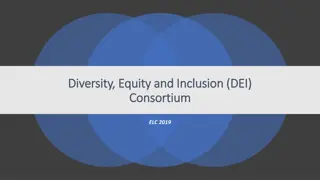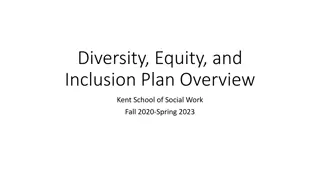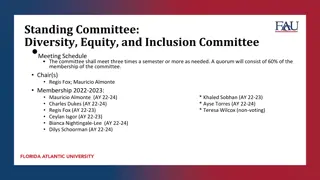Promoting Diversity, Equity, and Inclusion in Education: Student Bill and Anti-Racism Efforts
The Student Bill aims to ensure equal educational opportunities by embracing diversity, fostering an anti-racist environment, and creating inclusive classrooms. California Community College initiatives include addressing campus climate, implementing anti-racism curriculum, and promoting cultural awareness. The Anti-Racism Student Plan of Action focuses on cultural respect, equity training, curriculum changes, peer mentorship, and enhancing classroom experiences to combat racism and create a welcoming environment.
Download Presentation

Please find below an Image/Link to download the presentation.
The content on the website is provided AS IS for your information and personal use only. It may not be sold, licensed, or shared on other websites without obtaining consent from the author. Download presentation by click this link. If you encounter any issues during the download, it is possible that the publisher has removed the file from their server.
E N D
Presentation Transcript
ADDRESSING DIVERSITY, EQUITY, INCLUSION, ACCESSIBILITY AND ANTI-RACISM EFFORTS
What is this Student Bill?
A bill to ensure the equal educational opportunity of all students, we embrace diversity among students, faculty, staff, and the communities we serve. We are committed to fostering an anti-racist environment that offers equal opportunity for all.
Why have it?
The California Community College Chancellor s Office issued a call to action for campus leaders to host open dialogue and address campus climate; create an action plan to create inclusive classrooms and an anti-racism curriculum
The Student Senate for California Community Colleges adopted an Anti- Racism Student Plan of Action in 2020 that includes:
Cultural Awareness and Respect: A climate to allow students of color to feel welcome, free, and safe to express opinions Equity Training: Building cultural diversity awareness and addressing racism, unconscious bias, and microaggressions Curriculum Changes: a curriculum that fosters cultural appreciation, awareness, acceptance, & value Peer Mentors and Alliances: Resources for students to seek help and resources in addressing racism, microaggressions, building cultural diversity, and other racial barriers to their education (communication between student groups; peer mentor programs; faculty opportunities to share, learn, & listen) Classroom Experience: Faculty evaluation; include equity in hiring training; intentional recruitment of diverse full-time faculty; requires anti-racism statements.
Why is it important?
To ensure equal educational opportunity for all students Acknowledge institutional racism, discrimination, and biases that exist and eradicate them from our system Act deliberately to create a safe, inclusive, and anti-racist environment in our college.
How to implement it?
Department of Student Activities 1. Partner with representative and diverse Student Organizations on campus and aid in their events and hear their concerns 2. Formally recognize diversity months and days through specified bills (WIP) a. SB 16: Holocaust Remembrance Day b. SB 17: Black History Month 3. Put on events to honor diversity months and days 4. Invite distinguished speakers to share their worldview and educate us on how we can move forward
1. Conduct a campus climate survey: A campus climate survey can help identify areas where diversity, equity, inclusivity, accessibility, and representation are lacking and identify the needs of various communities on campus. The survey should include questions about the experiences of underrepresented groups on campus, such as people of color, LGBTQ+ individuals, students with disabilities, and others. 2. Provide training and education: Training and education can help faculty, staff, and students become more aware of issues related to diversity, equity, inclusivity, accessibility, and representation. Colleges can offer workshops, training sessions, and professional development opportunities to increase awareness and understanding. 3. Monitor progress: It is essential to regularly monitor progress towards diversity, equity, inclusivity, accessibility, and representation goals to ensure that they are being met. Colleges can use data and feedback from the campus community to make adjustments and improvements as needed.























